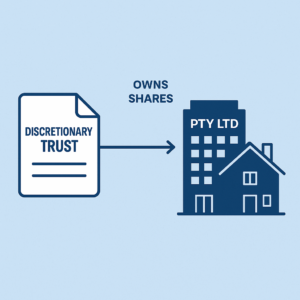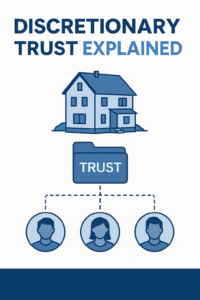Buying Property Through a Unit Trust in Australia: A Balanced Approach for Long-Term Investors
When building a property portfolio, the structure you choose can significantly affect your borrowing capacity, tax position, asset protection, and future flexibility.
One option that sits between simplicity and sophistication is the Unit Trust — a structure often used for joint property investments, family ventures, or partnership-style arrangements where each investor wants a defined share of ownership.
While discretionary trusts offer greater flexibility and protection, unit trusts provide clearer ownership interests and can still offer solid tax benefits if structured correctly.
Here’s what you need to know about buying property through a unit trust in Australia.
🏦 What Is a Unit Trust?
A unit trust is a legal structure where ownership of the trust’s assets (like property) is divided into units, similar to shares in a company.
Each unit holder owns a fixed portion of the trust’s assets and income, proportional to the number of units they hold.
For example:
If you own 60 units and your business partner owns 40, you hold a 60% beneficial interest in the trust and are entitled to 60% of its income and capital gains.
Unit trusts are often used when two or more investors contribute different amounts of capital but want their ownership rights clearly defined.
💰 Financing and Borrowing Capacity
From a finance perspective, unit trusts behave similarly to discretionary trusts:
-
Borrowing capacity in the short term may be lower, as lenders apply stricter assessments to trust entities.
-
However, in the long term, if the trust is trading profitably (i.e., generating consistent rental or investment income) and supported by accountant-prepared financials, some lenders may disregard existing trust debt when assessing the personal borrowing capacity of the unit holders.
This can provide better scalability over time — as each trust can potentially stand on its own financial record, separate from your personal income.
It’s worth noting that most lenders will still require personal guarantees from unit holders or directors of the trustee company.
🛡️ Asset Protection — Moderate but Conditional
From an asset protection standpoint, a unit trust offers some separation between the property and the individual investors — since the asset is legally owned by the trustee of the unit trust, not directly by the individuals.
However, protection is limited if the units themselves are owned personally.
If you personally hold the units and face legal or financial issues, those units (and thus your beneficial interest in the trust property) can still be targeted by creditors.
This is a key difference from a discretionary trust, where no one has a fixed entitlement, and therefore the assets are more effectively insulated.
To enhance protection, units can be held by another structure — such as a discretionary (family) trust — rather than in a personal name.
🏠 Land Tax Considerations
The land tax treatment for unit trusts is generally the same as for discretionary trusts.
Trusts are assessed under trust thresholds and rates, which vary between states and are often less generous than individual thresholds.
However, with strategic planning, multiple trusts can be used to manage or reduce overall land tax exposure, particularly for investors with larger portfolios.
Some states (like NSW and VIC) require the trust to be registered as a “fixed trust” or “family trust” to qualify for specific land tax concessions.
⚖️ Fixed Ownership Means Less Flexibility
A major distinction between unit and discretionary trusts is flexibility.
In a unit trust:
-
Ownership is fixed, based on the number of units held.
-
All income and capital gains must be distributed in proportion to those units.
-
Units cannot be reallocated or adjusted easily without selling or transferring them, which can trigger stamp duty and capital gains tax.
This makes unit trusts less flexible for tax planning or succession purposes compared to discretionary trusts.
Future changes in control or estate planning require the units to be formally transferred, which can complicate long-term wealth transitions.
🧾 Negative Gearing and Tax Treatment
Here’s where unit trusts can be particularly effective — if structured correctly.
Because unit holders have a fixed entitlement to the trust’s income and capital, interest deductions and other expenses can often be apportioned back to individual unit holders.
This allows individuals to potentially claim negative gearing benefits — offsetting their share of the trust’s property losses against their personal income.
This is one of the key advantages of a unit trust over a discretionary trust, which generally traps losses within the trust.
However, this benefit relies on:
-
A clearly drafted trust deed
-
Proper accounting documentation
-
The trust meeting the ATO’s requirements for being a “fixed trust”
Without these, negative gearing benefits may be disallowed.
📘 Example Scenario
Let’s take Ben and Alice, two friends investing in property together.
They set up the B&A Property Unit Trust, each contributing different amounts of capital:
-
Ben contributes 60% of the funds → 60 units
-
Alice contributes 40% → 40 units
The trust purchases an investment property through a corporate trustee.
-
Each investor receives income according to their unit holding.
-
Ben can claim 60% of interest deductions on his personal tax return (with proper accounting documentation)
-
If the trust generates profits later, those profits are distributed in the same proportions.
This gives them clear ownership and tax benefits — but limited flexibility for future adjustments or restructuring.
⚠️ Key Disadvantages
While powerful in the right context, unit trusts have several limitations to be aware of:
-
Limited Flexibility – Ownership and income distribution are fixed by the number of units.
-
Moderate Asset Protection – If units are personally owned, creditors can access them.
-
Complex Setup – Requires legal documentation, trustee company setup, and trust deed preparation.
-
Succession Challenges – Restructuring can trigger tax and duty consequences.
🧭 When a Unit Trust Makes Sense
A unit trust can be an excellent structure if you:
-
Are investing with partners, friends, or family members
-
Want clear ownership proportions and entitlement to income
-
Are seeking long-term scalability and potential negative gearing benefits
-
Can handle moderate setup costs and administrative complexity
It’s less suitable for:
-
Investors wanting maximum flexibility with income distribution
-
Those requiring high-level asset protection
-
Situations with many future beneficiaries or complex family dynamics
🧠 Trustify Insight
A unit trust sits between personal ownership and discretionary trust structures — combining the clarity of fixed ownership with some tax advantages and protection.
If structured correctly, it can be a powerful tool for joint investors or families building multi-property portfolios.
However, it’s critical to get the trust deed, accounting documentation, and legal setup right — as these determine whether you can access key tax benefits like negative gearing.
At Trustify, we help investors choose and design the right structure — balancing tax efficiency, finance strategy, and asset protection for sustainable property growth.
Information current as of October 2025. Reviewed by the Trustify Business Advisory Team. General information only — not financial or legal advice.
Others
-
October 20, 2025 Buying Property Under Your Personal Name in Australia: Pros and Cons
-
October 18, 2025 Service Trust Business Structure in Australia
-
October 18, 2025 SPV (Special Purpose Vehicle) Business Structure in Australia




